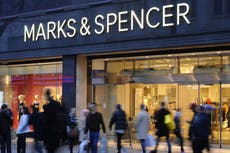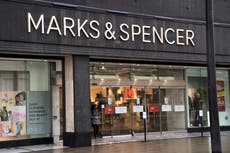After years of catch up, Marks & Spencer may finally be getting things right
For so long, the UK retailer’s profits had been sinking while others raced ahead with fashion and online shopping innovations – but the store’s fortune is changing, writes Chris Blackhurst


Every so often an invitation would land. Would I like to meet the boss of Marks & Spencer? With what appeared to be monotonous regularity, the name of the host would change.
It was Luc Vandevelde, who talked about putting the UK retailer head-to-head with Ikea and selling furniture and ornaments. There was Roger Holmes who tossed a plastic cube in the air, saying it represented “the values and strategies” of his leadership. It was covered in slogans such as “making aspiration and quality accessible to all”.
Stuart Rose injected some much-needed pizazz on the marketing side but more glamorous advertising did not translate into sustained upward profits. Then came Marc Bolland, who cut clothing ranges for the over 50s without enticing that vital age bracket into his stores.
On it went, a seemingly endless saga of lurching in one direction then handbrake turning.
It was only a matter of time before M&S followed so many other chains and closed its doors for good. Yet, for all the expansive talk on high, that this era would be different, what was wrong remained stark, staring obvious.
I wrote an article about the struggle of finding the shirt I wanted in the right size. Note, there are two requirements: the preferred garment and the fit. M&S had the shirt alright, but not in my measurements. They had my measurements alright, but not in the style I desired.
I wasn’t alone. Plenty of other folks described similar experiences. M&S had a flagship Marble Arch branch in London’s West End. From time to time as well, they would take journalists to see the blueprint for an entirely “new look” shop. I recall trekking to one and wondering how it departed from the existing model – whatever the changes, they were barely discernible to the casual observer and crucially, as it proved, to the shopper.
While this was occurring, away from London, in towns that had seen better days, perhaps when the local factories were humming, there was the reality of an M&S that had also fallen on hard times. There was the store in the northwest of England that pushed menswear upstairs, gave up the attempt to sell smart, trendy clothes and instead covered its shelves with dull jogging bottoms, dowdy T-shirts and boring jumpers. There were stacks of them but not a customer in sight.
At the same time, M&S’s competitors were moving heavily into online shopping. One, Next, moved seamlessly from stores-only to adding mail order and having a terrific internet service.
Rivals were quicker and sharper. Zara was cleaning up with clothes that women, and men, saw on TV or in magazines and wanted to buy. Theirs was not rocket science – they simply got on and did it.
The food stores now know what they are, promoting quality and value. The one near where I live is far busier all day long than the nearby Sainsbury’s and I would warrant they’re spending more too
In food, Waitrose was coming on strong at the top end, while below, Tesco was powering ahead as usual but was now joined by cut-price Aldi and Lidl. Waitrose partnered with new delivery service Ocado. M&S had the opportunity to get in there but took the view that it was not for them.
Then Bolland went and in came Steve Rowe as chief executive. He was joined by Archie Norman as chairperson, who had transformed Asda when it was stuck on a downward path.
Rowe took over in April 2016. Now, five-and-a-half years later we’ve been treated to the first M&S profits upgrade this century. That was three months ago. This week comes a second positive note: M&S’s half-year results beat forecasts and the firm again lifted its profits guidance. An incredulous City was caught napping – for decades they’d got used to M&S figures only going south, accompanied by another round of excuses.
Let’s not get carried away. Rowe was quick to say he would not “overclaim our progress”. M&S still has the same supply chain and shortages issues that other retailers have to contend with in the months ahead.
There was, though, even in that comment a sign that the Rowe and Norman approach is one of quiet purpose. They’ve analysed M&S’s problems – Rowe, who has more than 30 years experience at the retailer, knew what they were – and they’re tackling them. In relation to some of those who went before, that is a radical departure – not all of the company’s chiefs took the trouble to work out where the faults lay; they assumed they knew best. What’s also marked is Rowe and Norman’s determination to attack the issues head-on. Not everyone in the recent past was so single-minded.
I met Rowe and was left in no doubt that on his watch many of those forlorn outlets would go, and so it has proved. To the fury of councils, chambers of commerce up and down the land, media, politicians and a public who suddenly rediscovered their love for M&S, branches galore have been shed. This should not be under-estimated – every closure is accompanied by an outcry, but they’ve pressed ahead, regardless.
Their leaner and fitter company has cut back on unwanted lines and improved logistics and stocking. M&S, not Waitrose, now partners Ocado. Its online service operates smoothly and efficiently.
The food stores now know what they are, promoting quality and value. The one near where I live is far busier all day long than the nearby Sainsbury’s and I would warrant they’re spending more too.
Here’s the ultimate test: they have a shirt I want, in my size. Honestly, in the past where M&S was concerned, this would count as a miracle. Admittedly, I don’t have the same choice but what is the point in selecting one if they don’t have one you can wear? I never thought I would write this, but M&S may – just may – be getting it right at last.
Join our commenting forum
Join thought-provoking conversations, follow other Independent readers and see their replies
Comments



Bookmark popover
Removed from bookmarks